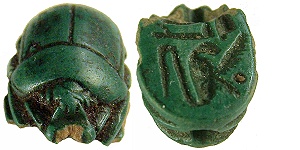Fine Coins Showcase
Antiquities Showcase
Hide empty categories
Shop Search
Shopping Cart
My FORVM
Contact Us
About Forum
Shopping at Forum
Our Guarantee
Payment Options
Shipping Options & Fees
Privacy & Security
Forum Staff
Selling Your Coins
Identifying Your Coin
FAQs
zoom.asp
Home ▸ Catalog ▸ |Antiquities| ▸ |Antiquities by Material| ▸ |Faience Antiquities||View Options:   | | | | | | Egyptian faience is a non-clay based porous crystalline ceramic composed of crushed quartz or sand, with small amounts of calcite lime and a mixture of alkalis. Faience was cast in molds to form objects and small vessels. A glassy surface luster was created by surface vitrification of a soda lime silica glaze. The most common color, a bright blue-green was made by adding a copper pigment. |


From the collection of Alex G. Malloy, former dealer in antiquities for 40 years.
This beaded Horus Falcon funerary ornament was likely placed on the chest of a mummy sheathed in strands of blue faience beads.AZ33397. Colorful beaded funerary ornament; cf. Alex G. Malloy, Ancient Art and Antiquities, Summer 1977, 17, Superb, 6 1/2" Horus Falcon with crowned head and spread wings, brightly colored turquoise blue, maroon, white, yellow, and black beads faience beads; intact with original strings; SOLD
Egyptian Blue Faience Votive Cup with Cartouche of Amenhotep III, c. 1391 - 1350 B.C.


Amenhotep III, meaning Amun is Satisfied, was the ninth pharaoh of the Eighteenth dynasty. According to different authors, he ruled Egypt from June 1391 B.C. to December 1353 B.C., or June 1388 BC to December 1351 or 1350 B.C.AB30968. height 5.7 cm (2 1/8"), turquoise-glazed faience cylindrical votive cup inscribed with the Cartouche of Amenhotep III, Choice, SOLD
Egyptian, Beaded Horus Falcon Funerary Ornament, Ptolemaic Period, 304 - 30 B.C.


From the collection of Alex G. Malloy, former dealer in antiquities for 40 years.
This beaded Horus Falcon funerary ornament was likely placed on the chest of a mummy sheathed in strands of blue faience beads.AZ33398. Colorful beaded funerary ornament; cf. Alex G. Malloy, Ancient Art and Antiquities, Summer 1977, 17, Superb, 6 1/2" Horus Falcon with crowned head and spread wings, brightly colored turquoise blue, maroon, white, yellow, and black beads faience beads; intact with original strings; SOLD
Egyptian, Beaded Horus Falcon and Kebhsenuf Funerary Ornaments, Ptolemaic Period, 304 - 30 B.C.


From the collection of Alex G. Malloy, former dealer in antiquities for 40 years.
These beaded Horus Falcon and Qebehsenuef funerary ornaments were likely placed on the chest of a mummy sheathed in strands of blue faience beads.AZ33396. Colorful beaded funerary ornament; Alex G. Malloy, Ancient Art and Antiquities, Summer 1977, 17, intact with original strings, Superb, 7 ¼" Horus Falcon with crowned head and spread wings, with pairs of 3 ½" Qebehsenuef, brightly colored turquoise blue, maroon, white yellow, and black beads faience beads; SOLD
Egyptian, XXII - XXVI Dynasty, Large Faience Amulet of Se Khmet, c. 945 - 525 B.C.


AS31155. Se Khmet amulet; cf. Lahun II, pl. 68, 1; Petrie Amulets -; 6.3 cm (2 1/2") high, fine aquamarine faience; crazing, Choice, SOLD
Egypt, New Kingdoms Period, Faience Cosmetic Vessel, 1550 - 1050 B.C.


AA99534. Faience unguentarium (cosmetic vessel); cf. Dayan collection p. 90, Collectible condition, complete and intact except for significant surface losses, one side remains attractive; 8.9cm tall, light blue-green faience (partially gone white), ovoid body, flaring mouth, flattened rim; painted black linear design: pattern of thin vertical leaves, between two lines with wavy line between above, and double line below, lotus flower at foot; ex Archaeological Center (Robert Deutsch, Tel Aviv, Israel, 2011), found in Israel; SOLD
Egyptian, Green Glazed Royal Scarab, Pharaoh Horemheb, 1319 - 1292 B.C.


From the collection of Alex G. Malloy, former dealer in antiquities for 40 years.
Horemheb was the last Pharaoh of Ancient Egypt's 18th Dynasty. His birth name and epithet was Horemheb Meryamun, meaning Horus is in Jubilation, Beloved of Amun. His name is sometimes spelled Horemhab or Haremhab. AF33302. Bright green glazed steatite scarab; 15 mm long, beautiful color, winged uraeus and part of hieroglyphic inscription naming Horemheb on base, Choice, base chipped at nose, SOLD
Egyptian, Faience Bead Necklace, New Kingdom, 1567 - 1085 B.C.


From the collection of Alex G. Malloy, former dealer in antiquities for 40 years. AM33385. Necklace, Choice, 21" long, two rows, 27 sections, multi-color faience bead necklace with light blues, whites, creams, and light browns; modern stringing; SOLD
Western Semitic, Phoenician, Faience Scarab, c. 1200 - 858 B.C.


This scarabus back type with a merging head and a notched clypeus was used in Egypt for a very long period, from the 11th to the 26th dynasty, from 2040 to 525 B.C. Although Egyptian domination of Phoenicia declined about 1200, scarabs remained popular and were made locally until the Assyrian vassalage beginning in 858 B.C.AS111469. Phoenician faience scarab, Choice, faience with green glaze, base with tiny chips at edge, light earthen deposits, 17.7mm long, pierced longitudinally, c. 1200 - 858 B.C.; obverse a kneeling radiate supplicant faces right pouring a libation towards a mummiform Osiris facing left, flanked by two hieroglyphs (n'b n'b – The lord of lords) bordering both ends; reverse molded scarabus back with legs on sides, merging head, and notched clypeus; ex Archaeological Center (Robert Deutsch, Tel Aviv, Israel), auction 50 (21 Apr 2011), lot 216; found in Israel; SOLD
Egyptian, Blue Faience Scarab, New Kingdom, 1550 - 1050 B.C.


From the collection of Alex G. Malloy, former dealer in antiquities for 40 years. AF33296. Egyptian scarab; 2 cm long, faience, superb fine blue glaze color, Men-Ab-Ra hieroglyphic on base, near Choice, SOLD

You are viewing a SOLD items page.
Click here to return to the page with AVAILABLE items.
The sale price for a sold item is the private information of the buyer and will not be provided.



REFERENCES
Page created in 1.266 seconds.






